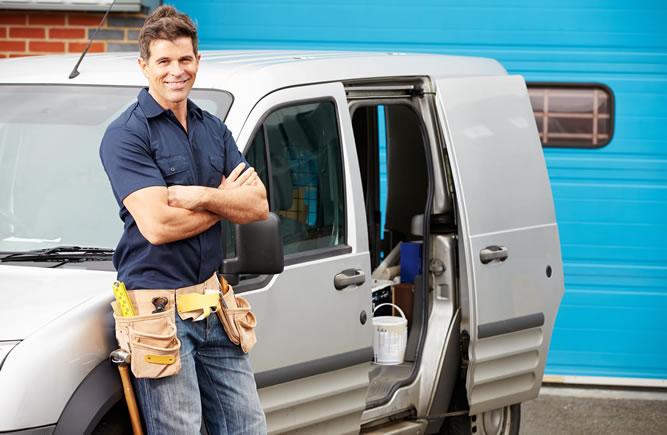Artificial Grass Installation Cost
Last updated 18th July, 2025
Looking to find out how much artificial grass costs to install?
In 2025, the average artificial grass installation cost is between £200 and £4,800. The price varies significantly depending on the size of the space you want to lay with artificial grass, as well as the quality of materials you want to use.
The artificial grass cost per square metre (m²) is around £22 per m² for budget options, about £34 per m² for mid-range options, and approximately £50 per m² for luxury choices. These estimates include materials and installation costs.
In this guide, we cover everything you need to know about artificial grass installation costs. This includes a breakdown of artificial grass prices (i.e., material costs), what impacts the cost of installing artificial grass, tools such as an artificial grass cost calculator, and much more!
Let's get started.
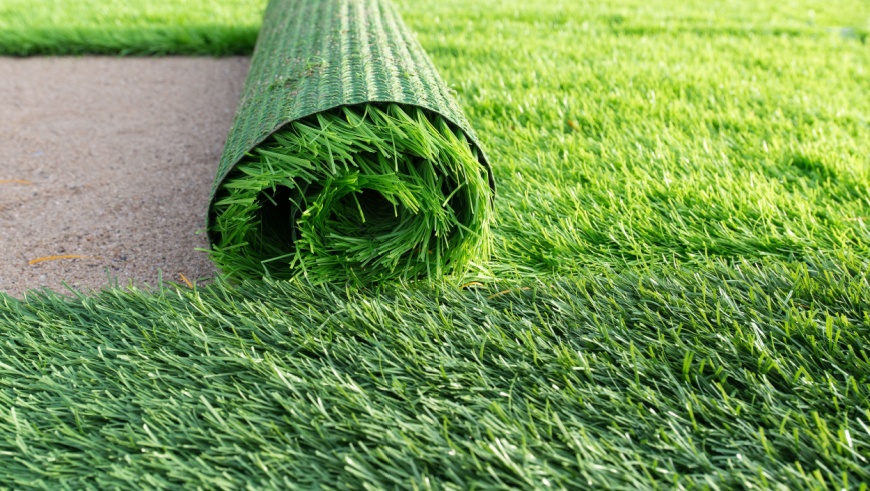
Table of contents
- How much to lay artificial grass in the UK?
- Labour cost to install artificial grass
- Factors that impact artificial grass installation costs
- Artificial grass maintenance costs
- The artificial grass installation process
- Types of artificial grass
- What can artificial grass be used for?
- What’s the best time of year to lay artificial grass?
- Benefits of installing artificial grass
- How long does artificial grass last?
- Is artificial grass bad for the environment?
- DIY artificial grass project
- Cost to remove existing turf
- Artificial grass removal cost
- Artificial grass alternatives
- How to find and hire an artificial grass installer
- FAQs
- Sources
How Much to Lay Artificial Grass in the UK?
Let's get right to the point: what should you expect to be quoted for installing an artificial lawn in your garden?
In 2025, the average cost of installing artificial grass is between £200 and £4,800. The price you're quoted for this job will depend on the size of your garden, as well as the quality of materials you're using. In particular, the type of artificial grass will impact the end cost.
Let's take a look at a few examples:
Artificial grass installation costs would be between £200 and £700 for a small space (10m²).
For an average-sized garden (about 50m²), the cost of installing an artificial lawn would be around £700 to £2,500.
And for a larger artificial grass installation (about 100m²), the cost would be between £1,400 and £4,800.
Artificial Grass Fitting Costs in 2025
The table below summarises artificial grass installation costs for different sized spaces using different quality materials. These estimates include the cost of buying the artificial grass and paying a tradesperson to lay it for you.
As we've already touched on, budget materials aren't advisable if you're looking to install an artificial lawn in your front or back garden.
| Garden Size | Grass Type & Thickness | Avg. Cost |
|---|---|---|
| 10m² | Budget (18mm – 25mm) | £200 – £300 |
| Mid-range (26mm – 30mm) | £400 – £600 | |
| Luxury (31mm – 45mm) | £600 – £700 | |
| 25m² | Budget (18mm – 25mm) | £400 – £600 |
| Mid-range (26mm – 30mm) | £700 – £1,000 | |
| Luxury (31mm – 45mm) | £1,100 – £1,400 | |
| 50m² | Budget (18mm – 25mm) | £700 – £1,100 |
| Mid-range (26mm – 30mm) | £1,200 – £1,700 | |
| Luxury (31mm – 45mm) | £1,800 – £2,500 | |
| 100m² | Budget (18mm – 25mm) | £1,400 – £2,200 |
| Mid-range (26mm – 30mm) | £2,200 – £3,200 | |
| Luxury (31mm – 45mm) | £3,300 – £4,800 |
Artificial Grass Prices
The table below shows artificial grass prices for material cost only (not including labour fees) and covers budget-friendly, mid-range, or premium quality options.
| Grass Type | Avg. Cost per m² |
|---|---|
| Budget (18mm - 25mm) | £8 – £16 |
| Mid-range (26mm - 30mm) | £15 – £25 |
| Luxury (31mm - 45mm) | £25 – £40 |
Generally speaking, cheaper options are better suited for displays and commercial use, rather residential gardens with a high footfall, whereas premium artificial grass is likely to look the most realistic.
Additional Artificial Lawn Installation Costs
When you're getting an artificial lawn installed, there are various other costs you should consider.
The table below highlights some of the most relevant other jobs you might want to complete before, during, or after the installation of new artificial grass.
| Description | Avg. Cost |
|---|---|
| Weed membrane | £0.50 - £1 per m² |
| Garden gate installation | £180 – £400 |
| Garden fencing installation | £700 – £1,000 |
| Tree removal | £200 – £750 |
| Garden lighting installation | £125 – £200 per light |
Artificial Grass Installation Cost Calculator
This section provides a breakdown of the individual costs for installing mid-range artificial grass in a 25m² garden.
Total Cost: £1,000
Materials
£650
Tradesmen
£250
Waste Removal
£100
Labour Cost to Install Artificial Grass
The cost of a gardener in the UK is between £200 and £250 per day. This means that a self-employed gardener will charge you around £25 to £31 per hour for their services.
Although they don't need to work in pairs to install artificial grass, they often do so that they can finish the job faster.
Removing existing turf, preparation of the ground, and installation of artificial grass will take between 2 to 3 days for an average-sized garden. Large gardens (measuring 100m²) can take around 8 days to complete, while a small garden (measuring 10m²) may take a day or less.
Something else to consider is the quality of the artificial grass that you're installing. Cheap artificial grass with a thickness of 18mm to 25mm should take between 1 and 4 days to install. On the other hand, luxury artificial grass with a thickness of 31mm to 40mm could take more than a week to be installed properly.
Factors that Impact Artificial Grass Installation Costs
Before hiring a professional to install your artificial grass, there are various cost factors you need to consider that will impact the end cost.
Type of Artificial Grass
The first major cost factor is the style you choose, which can vary depending on the length and thickness of the grass, prices are then normally charged per m²:
- Budget grass (18mm–25mm thick): £8 to £16 per m²
- Luxury grass (31mm–45mm thick): Up to £40 per m²
Size of Your Garden
Another important cost factor is the size of your garden, as the larger it is, the more expensive it will be. As a rough guide, below are two example showing either end of the price range:
- Small garden (10 m²): Around £200
- Large garden (100 m²): Up to £4,800
Ground Preparation
No matter how tempting to help cut costs, it's not possible to install artificial grass over real turf, so any existing lawn needs removing first. Avoiding excavation can help reduce costs, but if required:
- Landscapers typically charge £200–£250 per day
- The amount of turf and the garden’s size will impact total labour time and cost
Waste Disposal
Disposing of the existing turf once removed and any additional debris may be charged at an extra cost:
- Expect around £150 for waste disposal
- Cost may vary depending on volume and tradesperson
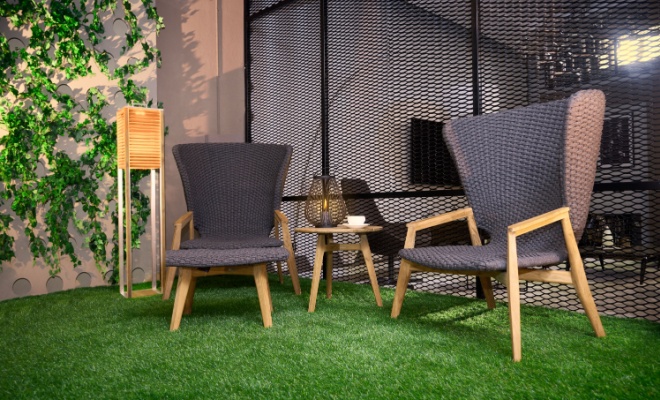
Artificial Grass Maintenance Costs
Although artificial grass is low-maintenance, it still needs to be cleaned every now and then. This involves clearing leaves and debris which can be removed using a leaf blower, which costs around £25 to £50 per day to hire.
If your artificial turf is damaged due to poor installation, burns from a barbeque, or exposure to harsh chemicals, you may be able to get it fixed by a professional for free, depending on your guarantee. Although the majority of installers will charge around £100 per day for repairs.
To repair any damage yourself, you will first need to remove the damaged area using a knife and replace it with a new piece of the same material.
Before securing the piece of turf, you should check the gauges on the back of the material, as this will indicate the direction that the new piece should be facing.
You should then remove the infill using a hoover, as this will ensure that the repair is completely flush with the rest of the installation. You should then cut the backing off, making sure you take extra care not to cut any of the fibres off.
Synthetic turf seaming tape should then be placed in the centre of the repair and should then be secured with nails. Adhesive can then be applied to the backing and the new piece secured in place. You should then place a 50-pound weight or bag of sand on top of the replacement, then after a few months of curing it can be removed.
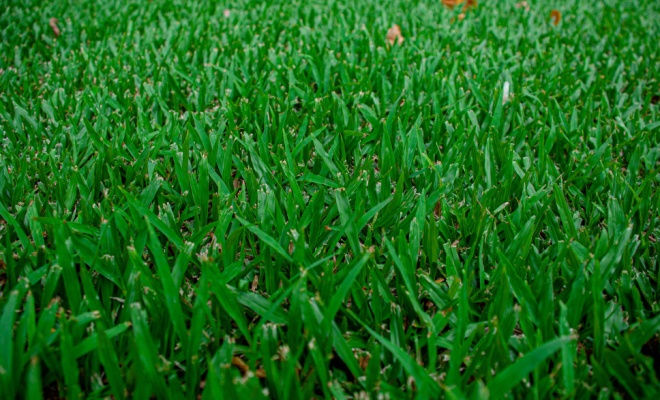
The Artificial Grass Installation Process
If you’re wondering how to lay artificial grass like a professional, it involves the following steps:
Ground Preparation
Before installing your new artificial grass, a professional installer will need to remove the natural turf by lifting it up with a spade or turf cutter, making sure they remove it to a depth of 10cm. They will then use a roller to compact the surface, spray the area with weed killer, and install an artificial grass underlay and weed membrane.
If there is no grass to be removed, then the installer will make sure the area is clean, smooth, and level before laying down your artificial grass. If the floor is not level or smooth, then they will put a layer of sand above the sub-base.
Stone aggregate will then be placed on top of the surface, which should be compacted to the desired level.
Artificial Grass Installation
Once your base is prepared, the artificial grass can be laid out, making sure that there is a 5cm gap on each side. This will then be left for around 2 to 3 hours to settle and reduce creasing.
After 3 hours, the grass will be turned over and trimmed with a sharp knife for a neat finish. An appropriate adhesive will then be applied to secure it.
If you have a large area that you want to cover, then the installer will have to join pieces of grass together using joining tape and adhesive.
Use tape on all joints, then sprinkle kiln-dried sand over the carpet to weigh it down. Finally, if you have timber edgings, you can nail the edge of the carpet to the edgings for a neat finish.
Laying artificial turf makes the lawn look spectacularly neat. So neat, in fact, that the rest of your garden will look positively shabby if not up to scratch! Because of this, you may want to consider upgrading the entire garden to match the stunning artificial grass — and take care of fencing, paths, borders, and any hard landscaping at the same time.
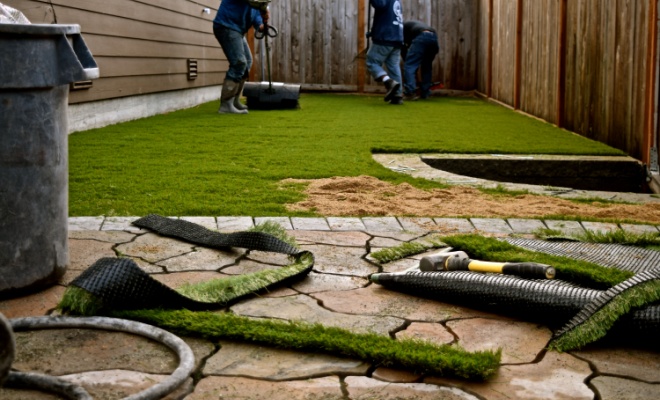
Types of Artificial Grass
There are various types of artificial grass you can choose from.
Let's take a look at the pros, cons, and average costs of different types of artificial grass.
Nylon Artificial Grass Cost
Nylon is a synthetic polymer with elastic qualities that are used in the production of artificial grass. It has a number of advantages and disadvantages, such as:
Pros
✔ Nylon material can withstand sun damage due to its high melting point.
✔ Suitable for gardens with a lot of foot traffic.
✔ Offers a natural aesthetic due to its ability to maintain the 3D look.
Cons
✖ Its high porosity makes it unsuitable for animal contact.
✖ Its stiff material makes it less comfortable underfoot.
-
✖ The most expensive option for artificial grass costs up to £40 per square metre.
Polypropylene Artificial Grass Cost
This material is a thermoplastic polymer that is made by combining propylene monomers together. It is used to manufacture artificial turf and offers a number of benefits and downsides, including:
Pros
-
✔ One of the cheapest materials costing around £10 per square metre.
✔ Ideal for low footfall areas.
✔ Offers robust qualities due to its stiffness.
Cons
✖ This material is susceptible to sun damage which causes the fibres to weaken.
✖ Not suitable for areas with a high level of foot traffic.
✖ Prone to breakages.
Polyethylene Artificial Grass Cost
Polyethylene is one of the most used thermoplastic materials due to its crystalline structure which makes it flexible for a number of applications including artificial grass production. To help you decide if this is the right material for your garden, take a look at the following pros and cons:
Pros
✔ A more flexible material which prevents breakages.
✔ Does not produce mildew or mould.
✔ It attracts less dust and dirt due to its low static charge.
Cons
-
✖ A slightly more expensive option with prices at £15 per square metre.
✖ Not as resilient as nylon.
✖ Susceptible to UV damage.
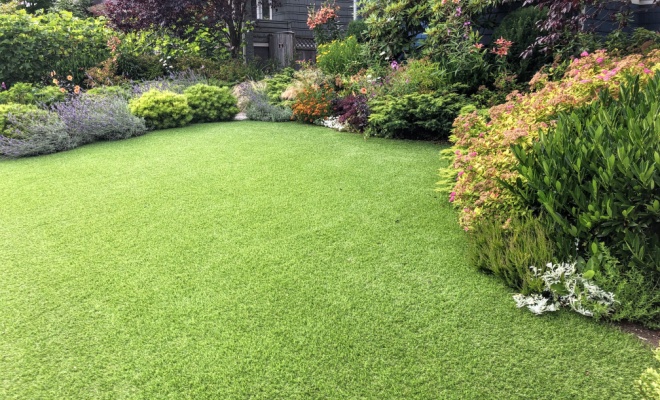
What Can Artificial Grass be Used for?
There are a variety of uses for artificial grass, with many choosing it for their front or back garden lawns, especially if they have children or pets. It is also ideal for areas where sport is played, such as tennis courts and football pitches which have a heavy footfall. You could also use it inside your home, with one of the most popular applications being indoor gyms.
If you have children, you may want to invest in artificial grass in play areas inside and outside of your home. This will prevent damage to your grass, as artificial grass is more robust than real grass.
You may also want to use it to improve the aesthetic of your home, for instance, you may want to install it on top of decking or balcony flooring, which will brighten it up and create the illusion of more green space.
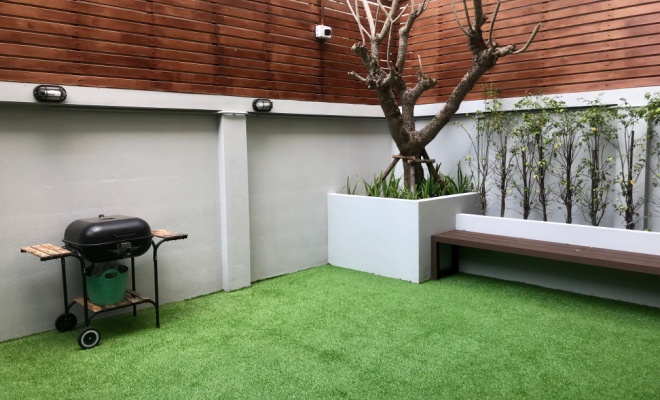
What’s the Best Time of Year to Lay Artificial Grass?
Artificial grass can be installed at any time during the year; however, spring is the most common period for installation. The reason for this is that the ground is usually soft due to months of rainfall in autumn and winter, which makes installation much easier.
However, if your lawn is waterlogged due to excessive rainfall, then it can be difficult to excavate, so you’re best waiting for your lawn to dry out.
The summer season is also a popular choice for artificial turf installation, as the weather tends to be better, and there are more daylight hours, which means your artificial grass can be installed quickly. In addition, the more sunlight there is, the quicker the turf will acclimatise to the ground.
However, if you have a lot of plants and shrubs in your garden, they will have grown fully, which may mean overhanging stems or weeds will need to be removed before installation.
Autumn and winter may seem like odd times of the year for installation, as long as the ground is not too dry or waterlogged.
During these months, there will be less chance of damage to shrubs and plants, as growth tends to decline. You can also benefit from shorter waiting times for installation, as there is reduced demand during autumn and winter.
Benefits of Installing Artificial Grass
Artificial grass is a plastic alternative to a real grass lawn that's much less hassle and time-consuming to maintain. It's a popular choice with homeowners who have shaded lawns (where real grass won't grow), poor soil that isn't suitable for optimal grass growth, or don't have enough time to maintain a real lawn.
Let's dive into the benefits of getting artificial grass installed a little more.
Low-Maintenance
The primary benefit of fake grass is low maintenance, obviously requiring no mowing or trimming whatsoever. Having artificial grass installed will prevent weed growth and patching, as this type of lawn material is not susceptible to diseases.
Lower Outgoings
As little to no maintenance is required for artificial grass, you will not have to spend money on products such as fertiliser, pesticides and garden tools. You will also use less water, as artificial grass does not need to be watered regularly.
Enhanced Aesthetic
Artificial grass offers an all-year-round aesthetic which does not change, regardless of the weather. This means your garden will look great even during heavy rainfall or snow.
Reduced Mess
Having artificial grass installed means you can avoid mud build-up during rainy seasons, which will ensure your garden is pristine. It also reduces the amount of dust and debris that clings onto the grass, as some types of turf have a low static charge.
Weather Resistant
Artificial grass is water and weather resistant so should last for a number of years before it needs replacing. This means it will not be affected by waterlogging or sunlight, as most turf installations are robust and have a high melting point.
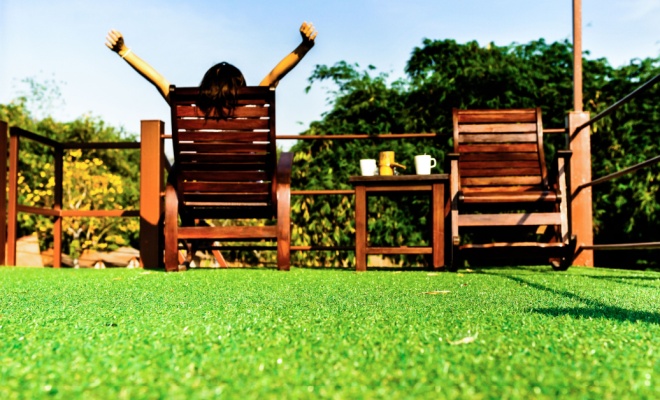
How Long Does Artificial Grass Last?
Artificial turf tends to last anywhere from 15 to 25 years, although the lifespan will depend on the material used and the level of footfall. For instance, nylon turf will last a lot longer, as it can withstand a high level of foot traffic, while polypropylene is better for low-footfall areas.
The majority of homeowners tend to replace their artificial grass every 10 to 15 years depending on its condition, as again its aesthetic will depend on the level of footfall. As the more people walk on the grass, the more the colour will start to fade and wear and tear will begin.
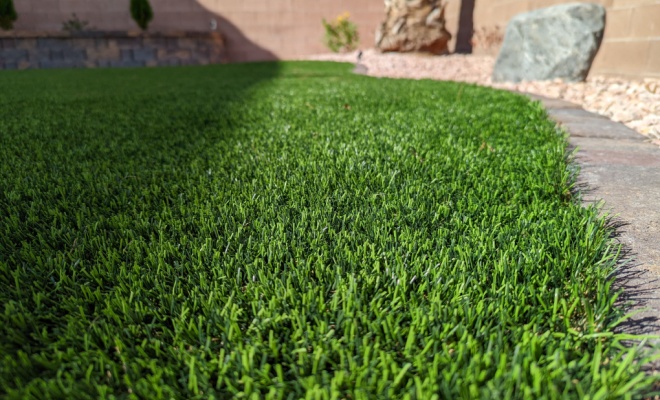
Is Artificial Grass Bad for the Environment?
Artificial grass has been criticised for its effect on the environment, as unlike real grass, artificial grass cannot be used as a habitat or source of food for some animals and insects.
While the production of artificial grass may be harmful due to the fact that most materials are non-recyclable, some companies are swapping materials for more eco-friendly alternatives.
Having artificial grass can also benefit the environment, as less maintenance is required, which means there are no harmful emissions being emitted from lawnmowers and strimmers. There is also no need to use any harsh chemicals that may be toxic to the environment, such as weed killers, pesticides and fertilisers.
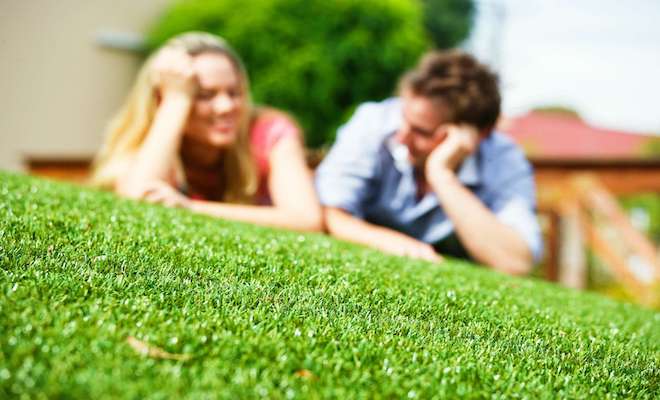
DIY Artificial Grass Project
Trying to do the job yourself and using the cheapest artificial turf never really works out well. We all like a bargain, but in the case of artificial turf, you actually do get what you pay for. The cheapest turf looks awful and is not convincing at all. It looks really fake, even from a mile away!
Not only that, but the cheap, lower quality material will weather faster and need replacing sooner, so in many cases, it's more cost-effective to spend more on a higher quality material which should only need replacing every 10 to 15 years.
But even the best artificial turf won't look great unless it is fitted correctly. Good quality artificial turf fitted well looks so much like real grass that you really can't tell unless you touch it. The only real giveaway is sometimes artificial lawns look so good they can't be real!
But even expensive high-quality artificial turf, if not fitted well to the borders and with perfectly hidden seams, looks completely artificial. Also, it is highly recommended to use a weed-proof mat under artificial turf to prevent weed growth from occurring.
Again, it adds to the expense, as does professional fitting, but you do get a better, longer-lasting job.
If you were considering laying artificial grass on a DIY basis, then you will need some basic tools, including:
Shovel (£7 to £30)
Wheelbarrow (£30 to £60)
Rake (£3 to £20)
Backing tape (£5 to £10)
Knife (£3 to £10)
Hammer (£3 to £25)
Fixing nails (£2 to £18)
You will also need additional materials such as timber for edge fixings, which costs around £7 to £10 per board, and kiln-dried sand with prices around £5 to £25 per bag. You will also need a weed-proof mat which tends to cost around £5 to £80, plus the artificial grass, of course.
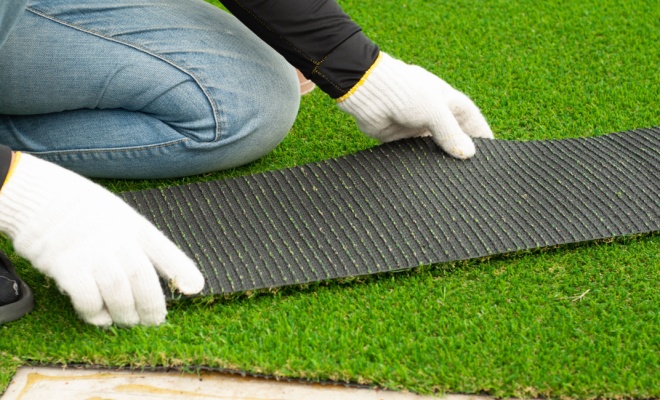
Cost to Remove Existing Turf
Before laying artificial grass, you'll need to remove your existing turf.
The average turf removal cost is £300 to £400. However, you'll also need to consider how you're going to dispose of this old turf. The typical cost to hire a skip is between £180 and £320.
When looking at the cost of garden waste removal, it's important to check the weight limits — as soil and old turf can be heavy, and you don't want to exceed any limits.
This preparation work is labour-intensive and will contribute the most significant chunk of time spent by a tradesperson on this project. This means it's also the area that contributes the most towards the total cost of fitting artificial grass.
The price of this work mainly depends on the size of your garden and your location in the UK. The larger the garden, the cheaper the cost per square metre — but the higher the overall price of removing the old turf.
This job involves using a lawn scarifier to remove the old turf and up to 20cm of soil. The ground is then levelled out and prepared for the installation of your fake grass.
If you want to save money, then you could remove the turf yourself with a spade and turf cutter. This will cost you around £40 to £150 to hire for the day. This tool lifts the existing grass, along with any plant matter, in preparation for your artificial grass installation.
Artificial Grass Removal Cost
Is your existing artificial grass looking a bit worn or damaged?
Removing artificial grass is a simple job that should be quite affordable. A professional gardener will charge between £200 and £250 per day that's required to remove your artificial grass. Once they've removed the old artificial grass, you should ensure that they inspect that the base is still in good condition before doing anything else.
You could also consider removing the artificial turf yourself (as a DIY project).
Here's what's involved in that:
First, cut the edge of the astroturf with a utility knife, then slice it into manageable pieces.
After you’ve cut it into sections, remove all the pieces. This may be difficult as artificial grass is usually stuck down with adhesive. However, you should try to remove as much turf as possible, put it in a rubbish bag, and then take it down to the local tip.
To remove the other pieces, you should use hot water to loosen the adhesive, then use a knife to peel away the turf.
Once the old artificial turf has been removed, you can then start to get rid of the adhesive with a heat gun (this costs between £20 and £150 to buy). You can then scrape the glue off using a knife.
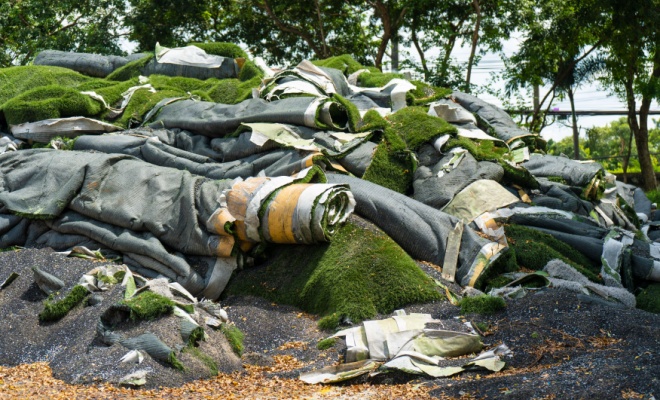
Artificial Grass Alternatives
The first thing to consider when investing in the cost of artificial grass is whether or not you're making the right choice to start with, especially when comparing it to laying a genuine lawn.
So before we take a look at other alternatives, let's review the pros and cons of real grass.
Real Grass
With the average cost of laying turf starting from just £150 for a medium sized garden (plus labour fees), real grass can be a relatively affordable option compared to the artificial alternative.
However, with a range of budget options to high-end choices that all require regular maintenance, real grass can come with its own advantages and disadvantages.
Pros
- ✔ Offers a natural aesthetic and fresh smell.
- ✔ Cheap and easy to install, as it costs around £6 per square metre.
- ✔ A more eco-friendly option.
- ✔ Doesn't have a limited lifespan.
Cons
- ✖ Needs regular maintenance.
- ✖ Susceptible to weed and moss growth.
- ✖ Susceptible to turf diseases.
- ✖ Must be fitted quickly once purchased.
So, if you're looking for budget grass, real turf is cheaper than the artificial alternatives. On the other hand, ongoing maintenance costs for turf can be high and caring for a new lawn will require close attention.
Decking
The cost of timber decking starts at £15 per square metre but can rise to £90 per square metre for premium materials. Meanwhile, the average composite decking cost per square metre is around £100.
Decking is often a popular choice as it provides another alternative to artificial grass that comes with without laying turf or having to worry too much about regular maintenance.
Pros
- ✔ Timber decking is more environmentally friendly.
- ✔ Wooden decking can be an attractive choice.
- ✔ Durable and long-lasting when properly maintained.
- ✔ Can be adapted to suit the space available.
Cons
- ✖ Composite decking isn't as eco-friendly as contains plastic.
- ✖ Costs can be higher in comparison to artificial grass.
- ✖ Decking may potentially fade with exposure to the sun.
- ✖ May require planning permission in certain scenarios.
Patio
The cost of laying a patio will depend on the materials you choose and how big the area is. However, the range is generally somewhere between £800 and £1,500.
A patio can be installed instead of artificial grass, providing an even surface in your garden for outdoor furniture.
Pros
- ✔ Straightforward to maintain.
- ✔ Different colour options.
- ✔ Has a good lifespan.
- ✔ Offers a flexible space in your garden
Cons
- ✖ Still requires some maintenance.
- ✖ Must be installed correctly to avoid drainage problems.
- ✖ Has high upfront costs.
- ✖ Not very eco-friendly.
Gravel and Stones
Pebbles, gravel or stones can be another low-maintenance way of improving your garden area, although it may not be the most comfortable option if you're wishing to sit and enjoying your outdoor space. Prices can vary, depending on the volume needed to cover your desired area.
Pros
- ✔ Doesn't require much maintenance.
- ✔ Straightforward installation.
- ✔ Durable and long-lasting.
- ✔ Wide range of options available.
Cons
- ✖ Still requires weeding.
- ✖ May require substantial quantity for a large garden area.
- ✖ Certain types of gravel can be easily displaced.
- ✖ Can become difficult to remove at a later date.
Wildflowers
Allowing wildflowers to grow is the most natural alternative to laying artificial grass. All it requires is a little garden maintenance, which you can either do yourself or hire a gardener at around £35 to £50 per visit.
Pros
- ✔ Attractive to look at.
- ✔ Cheap to purchase.
- ✔ Very environmentally friendly.
- ✔ Perennials will continue to bloom year after year.
Cons
- ✖ Not suitable for heavily shaded areas.
- ✖ Requires preparation in order to plant flowers.
- ✖ Needs regular watering during drier months.
- ✖ Can take time to see results.
Laying a Driveway
As a final suggestion, you may decide to do away with your front garden by converting it into a driveway in order to create off road parking for your property. On average, laying a driveway can cost anywhere from £500 to £8,000 depending on the work and materials involved.
Pros
- ✔ Solves issues with finding on road parking
- ✔ Can potentially add value to your property
- ✔ Reduces street congestion by creating more space
- ✔ Driveways are normally relatively low-maintenance
Cons
- ✖ Loss of green space can impact local biodiversity
- ✖ Aesthetically less appealing than a garden area
- ✖ Requires planning permission, especially for dropped curbs
- ✖ Likely to be a more expensive outlay than artificial grass
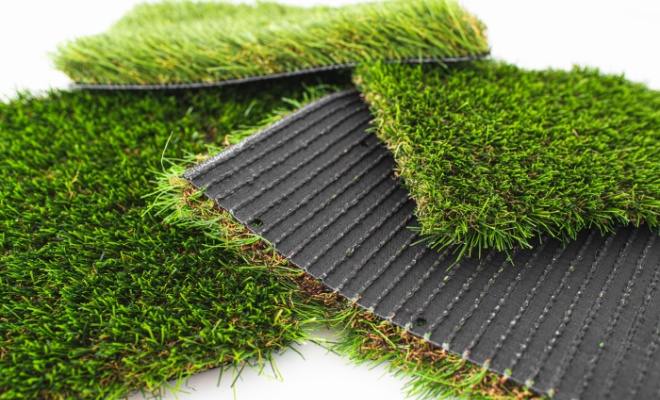
How to Find and Hire an Artificial Grass Installer
To ensure that your artificial grass is long-lasting and improves the aesthetic of your garden, you should hire an experienced tradesperson to install it. This will cost between £100 and £150 per day. How long it takes will depend on the size of your garden and the foundations in place.
When hiring an artificial grass installer, you should ask about their previous experience and if they have any examples of previous work. This will give you a good idea of what they're capable of doing for you.
You may also want to check if they have any qualifications. While this isn't a necessity, it's a good signal that they're a capable artificial grass installer.
You should also check that they have insurance. All tradespeople that you hire in the UK should have public liability insurance in place to protect them and you in the event of any damage or an incident.
FAQs
The biggest problem you'll have with artificial grass is when dirt collects on the surface. If this isn't frequently cleared away, then weeds can start to grow and can quickly start to look grubby. To prevent this, you'll need to occasionally wash the surface with clean water (just using a hose and brush, not a pressure washer).
This is all that's really required to keep your artificial grass looking in tip-top shape.
The lifespan will also depend on the quality of the installation. This is why it's important to hire a professional who knows how to lay astroturf properly.
You should also be careful with cigarettes. If they are disposed of carelessly on artificial grass, then they could melt a small patch of turf. So, make sure you have plenty of ashtrays to keep your artificial grass looking better for longer.
Artificial turf is also a great choice to have around children’s climbing equipment. If you want extra protection, you also have the option of installing a shock pad underlay underneath the artificial turf. This will help absorb the force if a child falls — while also keeping your garden looking more natural.
But if you have any pets, it's important to avoid installing artificial grass that's made of nylon, as it's porous. In this case, you should consider polyethylene materials. This is a more flexible material that has a low static charge that allows it to reduce the build-up of dirt and debris.
However, you will need to check that your concrete paving has the necessary drainage so that your artificial grass lasts as long as possible.
Sources
https://www.artificialgrassliquidators.com/artificial-lawn-benefits/
https://www.lovethegarden.com/uk-en/article/real-grass-lawns-versus-artificial-lawns
https://www.ccgrass.com/know-about-artificial-grass-drainage/
https://biofriendlyplanet.com/just-eco-friendly-artificial-grass/
https://royalgrass.com/blogs/tips-for-maintenance-of-artificial-grass/
